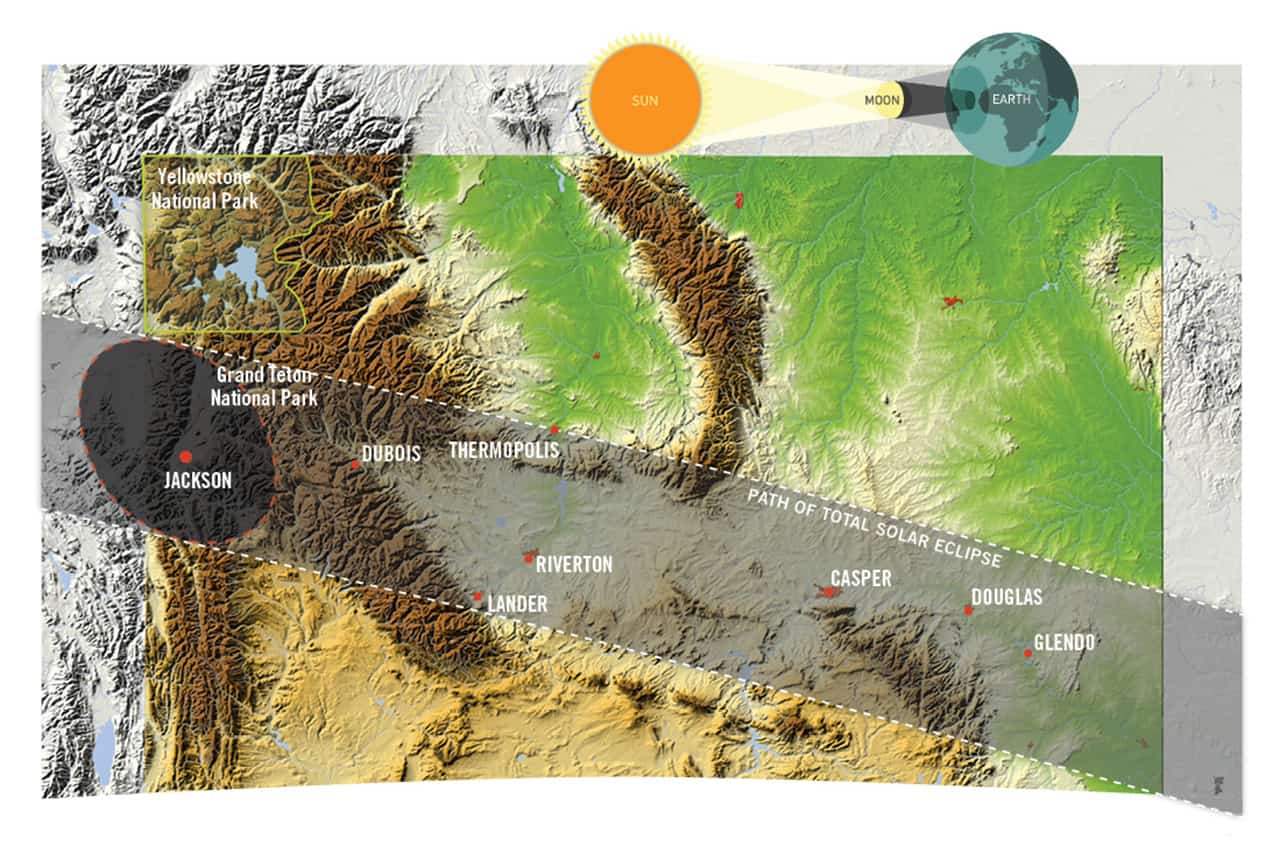Read The
Current Issue
Now You See It, Now You Don’t
August’s Great American Eclipse will darken the Tetons during the day for more than two minutes.
BY Mark Huffman
IT’S USUALLY GEOLOGY rather than geometry in outer space that brings tourists to Jackson Hole, but that’s changing—at least for a small window of time this summer. On August 21, 2017, the Great American Eclipse will start in Oregon and, en route to South Carolina, pass over the valley. This is the first total solar eclipse visible in the continental United States in thirty-eight years, and Jackson Hole is right in the path of totality, meaning the valley will experience complete darkness. The longest duration of darkness will be specifically at Jackson Hole Airport, seven miles from downtown Jackson, where it’s expected to last 2 minutes and 20 seconds, starting at 11:49 a.m. In the town of Jackson or in Teton Village, total darkness will be six to eight seconds less.
A solar eclipse is when the moon lines up perfectly in space to block the sun as seen from Earth. When the three are aligned, a giant circle of shadow hits our home planet and travels along at more than a mile every two seconds. Dr. Douglas Duncan, director of the Fiske Planetarium and a professor of astronomy at the University of Colorado, calls it a “seventy-mile-wide black dot.” Because the shadow travels across the landscape, people watching in Jackson can, with a little altitude, look west and see it coming. Watching from the sagebrush flats in Grand Teton National Park, you’ll see the Tetons go dark and, just for a second, you’ll still be in light.
“IT LOOKS LIKE the end of the world,” says Duncan, who has seen nearly a dozen total eclipses since 1970. “When the sun finally is covered by the moon, there’s pink flamers firing out. It’ll get cold and then dark, and then the animals will freak out. And then the people will freak out.” Four years ago, Duncan booked one hundred hotel rooms in the valley. He’s organized a group of close to three hundred umbraphiles—eclipse lovers—to travel here for the event. The tour package includes astronomy talks by Duncan and the NASA shuttle pilot who launched the Hubble Telescope, Steve Hawley. Dr. Samuel Singer, executive director of Wyoming Stargazing, a group planning a Jackson Hole observatory, says the total blackout “is what people are traveling from the other side of the world to see for two minutes.”
Duncan’s group is not the only one traveling here for the eclipse: Estimates are that the valley could have up to 100,000 more visitors than is usual for the end of August, prompting local officials in the area to be prepared. The Town of Jackson and Teton County earmarked $50,000 to hire an eclipse coordinator. (Kathryn Brackenridge isn’t coordinating the heavenly mechanics, but working to make sure things on the ground go safely.) Another $50,000 has been budgeted for associated public safety spending—and that doesn’t include overtime police and emergency workers in Grand Teton National Park, which spokeswoman Denise Germann says is calling for ranger reinforcements from other parks.
Wyoming Stargazing’s Singer is working with Snow King Resort to put on eclipse-watching events. People at the top of the ski hill will lose only about six seconds of totality because of their distance from the center line, he says, and will be in a prime location to see the eclipse coming. He hopes for “a raucous affair” that is equal parts astronomy and party. “The shadow of the moon will be streaking across the landscape at 800 mph,” Singer says. “It will be a line of darkness, like the darkest shadow of a cloud you’ve ever seen. I’m told it hits you like a ton of bricks.”





